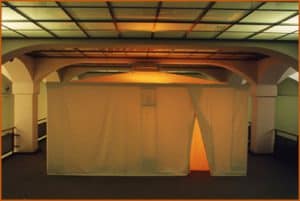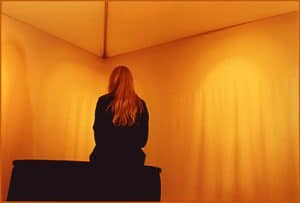This artistic concept is based on a self-contained enterable Space-soundBody as ‘space within (architectural) space’. Consequently, the enterable Space-soundBody also becomes circumambulatory.
Through the combination of the features of circumambulation and enterability, new qualities emerge which establish an autonomous type of space-sound installation art. An example of this is the Space-soundBody ‘Klangzelt’ (Soundtent) from the project series ‘SonicRooms’ (Fig. 9).
The architechtonic dimensions of the space surrounding the Space-soundBody itself is not explored acoustically – or to put it better ‘sonified’ – a process which would in a sense render the room itself ‘audible’. On the contrary, the installation aims to eliminate as much as possible the real – visual as well as acoustical – environment of the place where the enterable Space-soundBody is installed – it is in fact a room within a room.
The interior of the Space-soundBody entitled ‘Klangzelt’ (‘Sound Tent’) which is easily and effectively separated from its surrounding space by a double fabric cover, leaves aside as much as possible the visual aspect of the artistic design of space and time to intensify the auditory reception of the artificially created virtual SoundSpaces.
As visual contact, a crucial premise for orientation and localization, is prevented by thin draping which is impervious to light but permeable to sound, it is possible to create unreal-imaginary ‘SensorySonicRooms’, where actual moved sounds – perceived only by the ear – can be experienced as an amorphous continuum of fleeting and intangible conditions and acoustic atmospheres.
Paradoxically, the artificial spatial qualities of sound are even enhanced by actual movement. So, in order to experience the ‘Klangzelt’ adequately, you have to be there ‘live’, so that you may, for example, experience the difference between artificially produced spatial qualities in the stereo image and the artificiality of psychological “inner” perception of space, which is evoked by sounds tracing the actual distance from loudspeaker to loudspeaker.
On the other hand, there are artificial ‘listening islands’, which – similar to listening with headphones – shut out the real space of the location by means of surrounding fabric covers, so that the artificially produced spatial qualities of the spatial sound compositions themselves will be more authentically perceived. Thus, at these islands it will also be possible to achieve new listening experiences, which, among other things, may lead to irritations of the ‘normal’ perceptions of space and time. In the best cases the sound artwork evokes a free flowing SpaceTime experience between an imaginary, psychological inner space and an ‘actual’ physical exterior space.


